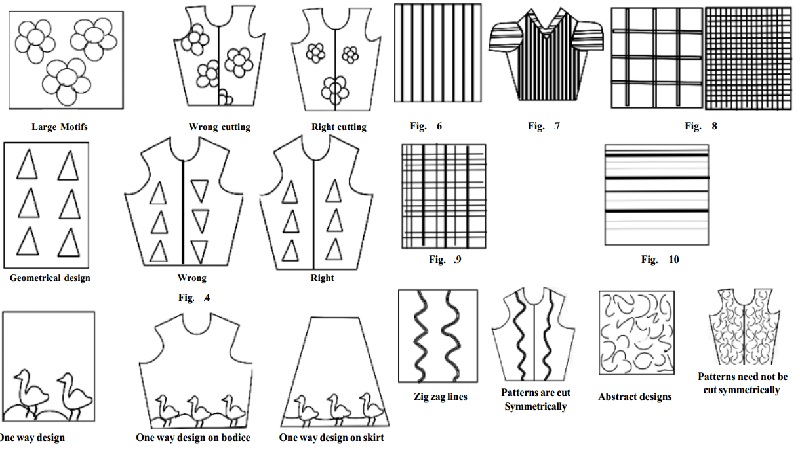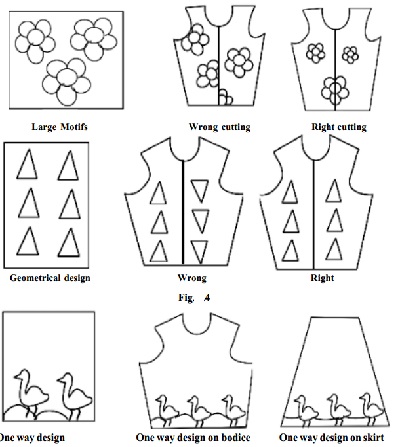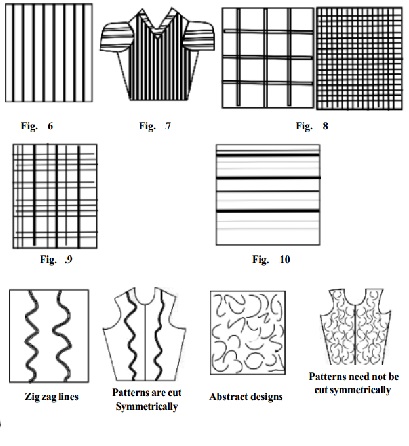Chapter: 11th 12th std standard Textiles And Dress Designing Cloth stitch Higher secondary school College practical steps methods Notes
Pattern Laying Based Upon the Design

Pattern
Laying Based Upon the Design
Design incorporated in a fabric should be emphasized to
enhance the personality of the wearer. Hence patterns should be laid carefully
to maintain the design and to harmonize it with the basic silhouette of the
dress. Some of the most common types of designs and the method of laying
patterns on them are discussed below.
1. Bold
Designs : Large motifs can be used for all
sort of garments, but they look best when
placed in an irregular fashion. This concept can be assure only with
placement of the motifs. If a fabric has too many motifs arranged in a crowded
manner or a irregular pattern, they can be placed next to each other, cut and
sewed. Since the fabric does not follow a define pattern the garment will not
look odd (Figure).
When the material has well designed large motifs repeated
after equal distance, place these designs on to the center of the pattern.
Don't cut through large motifs because it is difficult to match seam lines
(Figure).
Pattern laying techniques vary based upon the designs also.
So a dress designer should observe the type of design and the repeat of the
design.
2. One-way
Design : One way designs can be printed or
woven. Design go in one direction Eg. Group
of flowers on a creaper can be woven from selvege to selvage in the lengthwise
direction or a group of geometrical designs can be printed (Figure).
When patterns are laid on these type of fabric one must
carefully check if the seam lines on one pattern match with the design of the
pattern which is joined. Eg. If a blouse pattern with front opening is cut on a
one way design, place the patterns in such a way that both the right and left
blouse patterns are alike (Figure).

3. Stripes and plaids : Stripes are straight lines running in the lengthwise or
crosswise direction. These stripes
are called as vertical stripes and horizontal stripes (Figure). Stripes are
most commonly used in shirt patterns. They can be cut in lengthwise and
crosswise directions to create zig-zag effects on garments. Collar, sleeve,
pocket patterns can be cut in cross grain on vertically striped material to
create interest to the garment (Figure).
Plaids
are lines woven or printed in both lengthwise and crosswise direction. Plaids
create a checked effect (Figure).
Stripes
and plaids can be even or balanced and uneven or unblanaced. Even or balanced
strips and plaids can be described as lines or bar arranged in a definite
colour or placement. The size of the bars and stripes are similar. The
variation occurs in the type of yarn or colour of the yarn used (Figure).
Uneven or unbalanced is just the opposite. Here bar and stripes of different
sizes, colours and spacing are arranged in a systematic manner (Figure).
4. Border
Designs: These designs run along one selvedge
only. They can be woven or printed. The
design can be used along the hem lines of the bodice, skirt and sleeve
patterns. In order to maintain the design line some patterns like yokes and
collarsareto cut on straight grain. These fabrics cannotbe used for curved
edged garments like flared skirts. One must make sure that the hemlines are
straight to follow this design. While placing pattern on these designed
fabrics. One must take care to match the designs. Eg. the front and the back
bodice pattern must have the same thread of design at the side seam but it need
not be similar in case of abstact designs. (Figure).
Open layout out or off center lengthwise layout will suit these type of fabrics.

Related Topics